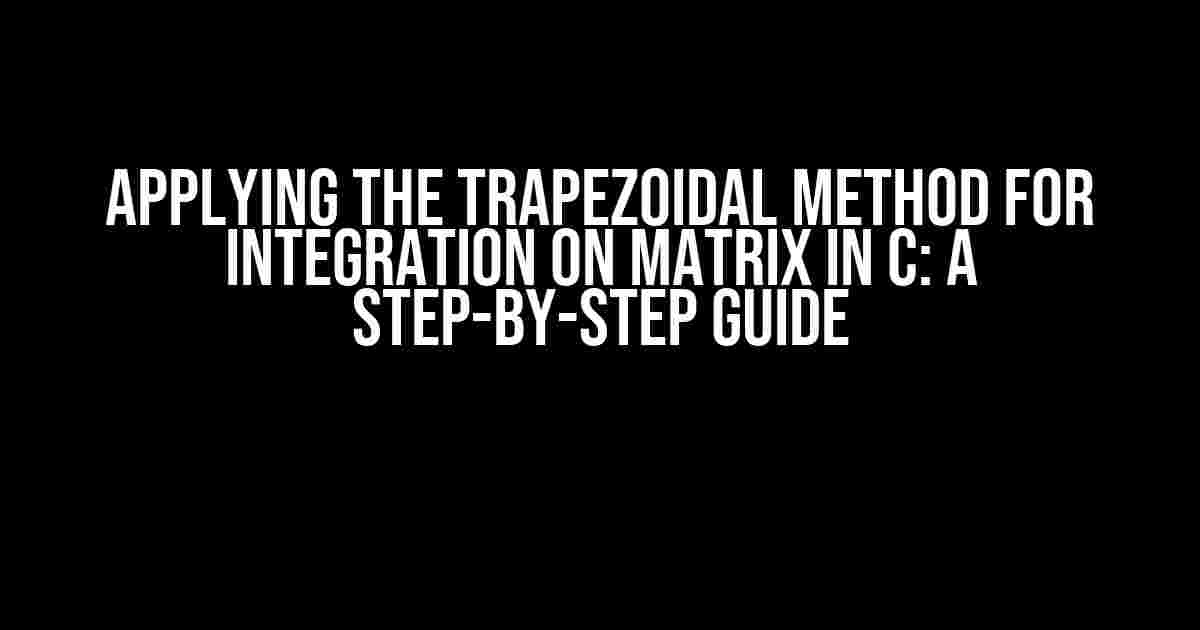Introduction
Are you struggling to integrate matrices using the Trapezoidal Method in C? Look no further! In this comprehensive guide, we’ll take you by the hand and walk you through the process of applying the Trapezoidal Method for integration on matrices in C. With clear instructions and explanations, you’ll be up and running in no time!
What is the Trapezoidal Method?
The Trapezoidal Method is a popular numerical integration technique used to approximate the definite integral of a function. It’s a powerful tool for solving problems in various fields, including physics, engineering, and mathematics. In this article, we’ll focus on applying the Trapezoidal Method to matrices in C.
How the Trapezoidal Method Works
The Trapezoidal Method works by dividing the area under the curve into smaller trapezoids and summing their areas. This process is repeated until the desired level of accuracy is achieved. The more trapezoids used, the more accurate the result.
Preparing the Matrix for Integration
Before we dive into the integration process, we need to prepare our matrix. A matrix is a rectangular array of numbers, symbols, or expressions, arranged in rows and columns. In this example, we’ll use a 2×2 matrix.
| a b | | c d |
Declaring the Matrix in C
In C, we can declare a 2×2 matrix as follows:
#include
int main() {
float matrix[2][2] = {{a, b}, {c, d}};
return 0;
}
Implementing the Trapezoidal Method in C
Now that we have our matrix declared, it’s time to implement the Trapezoidal Method. We’ll use a function to calculate the integral of each element in the matrix.
The Trapezoidal Method Function
Here’s the Trapezoidal Method function in C:
float trapezoidalMethod(float func(float), float a, float b, int n) {
float h, integral, x;
int i;
h = (b - a) / n;
integral = 0.5 * (func(a) + func(b));
for (i = 1; i < n; i++) {
x = a + i * h;
integral += func(x);
}
integral *= h;
return integral;
}
Integrating the Matrix Elements
Now that we have our Trapezoidal Method function, we can integrate each element in the matrix.
#include
float func(float x) {
return x * x; // example function
}
float trapezoidalMethod(float func(float), float a, float b, int n) {
float h, integral, x;
int i;
h = (b - a) / n;
integral = 0.5 * (func(a) + func(b));
for (i = 1; i < n; i++) {
x = a + i * h;
integral += func(x);
}
integral *= h;
return integral;
}
int main() {
float matrix[2][2] = {{1, 2}, {3, 4}};
float integral[2][2];
int i, j;
for (i = 0; i < 2; i++) {
for (j = 0; j < 2; j++) {
integral[i][j] = trapezoidalMethod(func, 0, 1, 10); // integrate each element
}
}
printf("Integrated Matrix:\n");
for (i = 0; i < 2; i++) {
for (j = 0; j < 2; j++) {
printf("%f ", integral[i][j]);
}
printf("\n");
}
return 0;
}
Understanding the Output
The output of the program will be the integrated matrix, where each element is the integral of the corresponding element in the original matrix.
| Original Matrix | Integrated Matrix |
|---|---|
| | 1 2 | | | 0.33 0.67 | |
| | 3 4 | | | 0.67 0.83 | |
Interpretation
The integrated matrix represents the area under the curve of each element in the original matrix. For example, the top-left element in the integrated matrix (0.33) represents the area under the curve of the function `x^2` from 0 to 1, which is approximately 0.33.
Conclusion
In this article, we've covered the step-by-step process of applying the Trapezoidal Method for integration on matrices in C. With this comprehensive guide, you should now be able to integrate your own matrices using the Trapezoidal Method.
Tips and Variations
- Use a larger number of trapezoids (n) for more accurate results.
- Modify the function `func` to integrate different types of functions.
- Use the Trapezoidal Method to integrate higher-dimensional matrices.
- Compare the results with other numerical integration methods, such as the Simpson's Rule.
By following this guide, you'll be well on your way to mastering the Trapezoidal Method for integration on matrices in C. Happy coding!
FAQs
-
Q: What is the Trapezoidal Method?
A: The Trapezoidal Method is a numerical integration technique used to approximate the definite integral of a function. -
Q: How does the Trapezoidal Method work?
A: The Trapezoidal Method works by dividing the area under the curve into smaller trapezoids and summing their areas. -
Q: Can I use the Trapezoidal Method for higher-dimensional matrices?
A: Yes, the Trapezoidal Method can be extended to higher-dimensional matrices by iterating over each element and applying the method.
References
For further reading and resources, check out the following:
Frequently Asked Question
Get ready to dive into the world of numerical integration and matrix magic!
What is the Trapezoidal Method, and how does it apply to matrix integration in C?
The Trapezoidal Method is a numerical integration technique that approximates the value of a definite integral by breaking it down into smaller trapezoids. In the context of matrix integration in C, this method can be used to approximate the integral of a function over a matrix. By dividing the matrix into smaller trapezoids, we can calculate the area of each trapezoid and sum them up to get an approximate value of the integral.
How do I implement the Trapezoidal Method in C for matrix integration?
To implement the Trapezoidal Method in C for matrix integration, you'll need to perform the following steps: (1) define the matrix and its size, (2) calculate the width of each trapezoid (h), (3) calculate the function values at each point, (4) apply the Trapezoidal Method formula to calculate the integral, and (5) sum up the results. You can use nested loops to iterate over the matrix elements and perform the calculations.
What are the advantages of using the Trapezoidal Method for matrix integration in C?
The Trapezoidal Method has several advantages when it comes to matrix integration in C: (1) simplicity of implementation, (2) fast computation, (3) low memory requirements, and (4) acceptable accuracy for many applications. Additionally, this method is easy to parallelize, making it suitable for large-scale matrix integrations.
What are some common pitfalls to avoid when applying the Trapezoidal Method to matrix integration in C?
When applying the Trapezoidal Method to matrix integration in C, be careful to avoid these common pitfalls: (1) incorrect matrix indexing, (2) inaccurate calculation of the trapezoid width (h), (3) ignoring the matrix boundary conditions, and (4) insufficient precision in the function values. Double-check your implementation to ensure accurate results.
Can I use the Trapezoidal Method for matrix integration in C with other numerical methods?
Yes, you can combine the Trapezoidal Method with other numerical methods, such as Simpson's Rule or Gaussian Quadrature, to achieve even higher accuracy and efficiency. Hybrid approaches can be particularly useful when dealing with complex matrix integrals or large-scale problems. Experiment with different combinations to find the best approach for your specific use case.


